X: Forty years of excellence, celebrated at the Grammy Museum
Steve Hochman on
2

John Doe was looking at a notebook he’d kept from years ago.
“This was the first time I wrote down the words for ‘Los Angeles,’” he said, referencing the title song of his band, X’s, debut album from, well, many years ago.
He read a few lines out loud, though they weren’t exactly what we know from the song, not even exactly lyrics, more like some observations, some thoughts.
“It’s not complete,” he added.
It’s also behind glass. Doe was reading it as it sat mounted in a display at the Grammy Museum at L.A. Live, surrounded by other items from his live in the case dedicated to him as part of the new “X: Forty Years of Punk in Los Angeles” exhibit, which will be up through March 2018.
Bassist-songwriter-singer Doe, singer-songwriter Exene Cervenka, guitarist Billy Zoom and drummer D.J. Bonebrake each has his/her own case of mementos — instruments, clothing, photos and assorted items, but this is really about the collective power not just of the band, but of a community that it helped spark, while also in many ways transcending with a range of ambitions and expressions that still to this day deny and redefine the term “punk.” Band photos line the walls around the cases, and performance and other clips from the 1986 documentary “The Unheard Music” take us on a trip from the day Baltimore-transplant Doe and Florida-refugee Cervenka met at a poetry workshop at the Beyond Baroque bookstore in Venice up to, well, right now.
This particular right now was late afternoon Friday as the band prepared for a the official opening of the exhibit. There would be a lively interview session in the Clive Davis Theatre conducted by museum executive director Scott Goldman, followed by a masterfully exhilarating rooftop patio concert which showed the band still growing, still vital as ever. But here, before, Doe had been asked to pick out one item in the whole exhibit that for him is the keystone of what he and X built, the wellspring of the history represented. After stopping to indulge a fan, a big guy named Eric wearing an AC/DC T-shirt who wanted to tell a story of when he first saw X and have Doe sign some old vinyl album covers, he pointed to this notebook.
Bonebrake was also set with the same task and pointed to his first full drum kit, set up on a stand near the cases, and in particular to a parade-style snare drum, which he says got him the X gig in the first place. But we’ll let each of them tell the tales:
John Doe’s notebook:
“I carried it around in my back pocket, which is why it’s sweaty.”
Indeed, the pages are with watermarked, sweat-marked, with smudges of run ink, blue and black.
His attention went momentarily to an adjacent item, a beat-up but beautiful instrument.
“That’s the first real bass I bought, a real-deal Fender. 150 bucks.”
Then back to the notebook.
“My method of writing at that point and even now sometimes is to write stuff because I hear it in my head, and then later shape it to music. This one is about our friend Faye who moved to England early on. She had just had it with life in L.A., which is why she devolved into racism, and blaming people. She wasn’t that way normally.”
A short pause to consider how relevant that still seems in today’s cultural climate. But surely he couldn’t have had it in mind how the song would resonate decades later. And surely he didn’t save the notebook and other items thinking they’d someday be in a place and context such as this.
“I kept things because they’re mine.”
But then he considers it some.
“When I moved out here, I planned on being … something. I didn’t know what. But I save things, save letters sent back and forth, in case someone would someday want to put them out. Maybe it’s pretentious, but why not me? I can write.”
And now here it is.
“It’s great.” He catches himself. “It’s not great. ‘Great’ is too dull a word. It’s a little oppressive, because you don’t want to think of yourself as dusty and belonging in a museum. But also, there’s gratitude because you’re here to enjoy it.”
D.J. Bonebrake’s drum:
“I’d have to start with an instrument. If one thing was distinctive, I played a marching snare. Bought it in ’70 or ’71. Painted a house to buy it new for $160. I was playing it with the Eyes [his pre-X band at the seminal Masque punk club in Hollywood] when John first saw me. Billy had said when they were forming the band, ‘We want a guy who plays a big snare. John called him right from there.”
What was it about that drum that mattered to Zoom?
“I don’t know.”
But when he went to meet with Zoom, Doe and Cervenka he understood from the start that they were not typical of the bands in the nascent L.A. punk scene.
“What I was attracted to was the variety of songs. Playing in that world, instead of bands becoming more diverse, it just became more punk.”
But…
“When I showed up to the first rehearsal, I brought a different drum, smaller. It was hard to find a stand for the marching snare. Later Billy used a hacksaw to make a stand lower so I could use that with my kit.”
Whatever that contributed to X’s distinctive sound and approach, the vision and ambition found expression that proved hard to limit with any genre definition.
“People would say, ‘You guys are like Elvis Costello.’ That was supposed to be a put-down!”
Assessing the whole of the exhibit and what it represents, it’s hard for him to grasp it all.
“Am I there yet? I’m just trying to take it in. When you start looking through things, it’s like looking through family photos, everyone knows that feeling — ‘Look! Remember that?’ But the bigger picture … I have to think. I’m still in the middle of it.”
Doe and Bonebrake each spontaneously also focused on items in one of their bandmate’s cases, Doe turning to point out an aqua-blue dress in Cervenka’s display and Bonebrake a gold, or at least gold-ish record in Zoom’s.
Cervenka’s dress (described by John Doe):
“My favorite of Exene’s is this dress she got married in in Tijuana.”
He, of course, was the other participant in the marriage, which lasted just five years.
“April 6, 1980. There’s our wedding party.”
He points to a photo of the two of them seated in a booth at the bar La Ballena, stony, shell-shocked looks on their faces. In other times he’s talked about how a couple people in their wedding party got thrown in jail for drunkenness and brandishing switchblades. Then another photo below that, a street scene.
“Leaving the lawyer’s office. We just signed a paper, and we were married.”
Zoom’s gold record (per D.J. Bonebrake):
“Billy made them, after ‘White Girl’ came out. He had a friend make fake gold records. He gave each of us one. I saved mine and presented it. That’s the one in Billy’s case.”
No one’s going to be fooled, of course. It looks like a gold-paper flexidisc, with a label from the original 1980 Slash Records single pasted on it. Not to mention that the song never made the pop charts at all. Only one X song did — 1985’s “Burning House of Love,” peaking at No. 27.
Well, charts schmarts. Here we are 40 years down the road, and X is still as strong as ever. Following Goldman’s interview in the Clive Davis Theater, the select gathering headed up to the patio where X gave a performance with as much energy and power as ever, clearly fueled by the recognition received this night — and two days earlier when the band was, improbably, given a career-honor proclamation by L.A. Mayor Eric Garcetti and the City Council, this just weeks after, even more improbably, there was X night at Dodger Stadium, Doe singing the national anthem and Cervenka throwing the ceremonial first pitch.
If any song from the Grammy Museum performance might serve as the centerpiece, the summary of the still-strong mission statement of this band, it was “Hungry Wolf,” originally on the 1982 album “Under the Big Black Sun,” which saw the band leaping from indie Slash to major Elektra. What better than a ferocious song about bonds enduring through life in the wild. And in case anyone might think they’re just about nostalgia, the middle section took the band into unexpected places with Bonebrake’s pounding drums, Zoom’s distorted guitar, and Cervenka’s and Doe’s Expressionist howls. It was Gene Krupa via “Whole Lotta Love.” Or vice versa. “Ready to tear up the world.” From the dank basement of the Masque in ’77 to the swank rooftop of the Grammy Museum in ’17, they still roam.
Photos by Alison Buck/WireImage.com


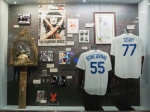
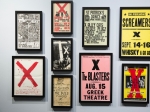
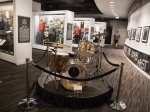
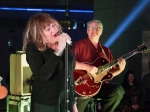
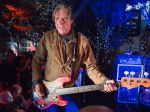
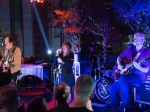

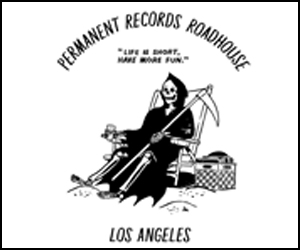


So much love for this band and their music. I’ve been on board for 37 of their 40 years, and I’ll never stop loving them. X and their fans, who I’ve met so many of at shows over the years, are the best!
[…] Legendary punk rockers X, whose legacy is currently being celebrated with an exhibition at the Grammy Museum, celebrate their 40th anniversary with a show Wednesday night at the Novo. […]